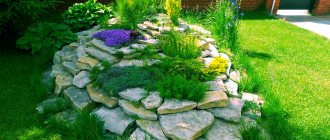Japan has long attracted residents of other countries with its mysterious philosophy and culture, which are very clearly manifested in the field of Japanese landscape design style. The Japanese garden is the embodiment of the Land of the Rising Sun on a single territory. The purpose of its creation is to have a positive impact on the owner’s life, support his vitality, help him find inner harmony, and relieve stress. It attracts with its practicality and simplicity; it reveals a philosophy unique to it. It is very difficult to create, but it is quite simple to maintain, although at first glance it does not seem so.
A little history
The goal of any direction of landscape design is to simultaneously combine human influence and the riot of natural elements as skillfully and naturally as possible. This harmony is most fully reflected by a garden designed in the traditions of the Land of the Rising Sun. The principles of its creation have been honed over centuries, therefore, today there is a whole doctrine that modern designers take as a basis and create magnificent man-made parks.
The word "garden" first appeared in Japanese manuscripts in the eighth century AD. Initially, it was used to designate a separate space that did not have any artificial fences. Objects began to appear inside it that allowed a person to move around the area and admire the beauty of nature. These were stone paths, small architectural forms made of them - resting places.
The garden is like a picturesque picture Source akspic.ru
Servants were introduced to them to ensure cleanliness. Gradually they began to improve the objects entrusted to them. During the Heian period, science and painting flourished. It was so popular that even gardeners tried to paint pictures using plants. They created such stunning masterpieces that they were admired by everyone without exception. This concept of landscape design of the Japanese garden dominated during the heyday of the Yamato-e school. When the samurai came to rule, pomp and excessive decorativeness gave way to monochrome and laconicism. The era of the “dry” landscape has arrived. Her idea determined the basic principles of the modern movement.
Stones and more stones...
Their importance for the Japanese garden is enormous.
Firstly, stones are used to lay out a recreation area - a patio. As well as the main path going deep into the garden. For it, large slabs with uneven edges are chosen, and smaller samples are used to cover secondary paths and boundaries between zones. Secondly, stones are needed for a dry landscape, in other words, for a rock garden. The fact is that in the old days the Japanese believed that gods lived among scattered blocks and boulders. Since then, the rocky landscapes have been a place where monks meditate.
At the heart of the rock garden is a heptagon of lines, at the intersection of which large fragments of flagstone, granite, and quartz are installed. The space between them is covered with pebbles, on the surface of which waves are drawn.
Stones are selected taking into account both shape and color. Gray and bluish are identified with the element of water, greenish with vegetation, and stones of strange shapes symbolize animals in the garden.
The stone garden should be located in such a way that the sun does not blind the eyes of those who admire it.
The more varied the shape of the fragments, the better. In this case, there must be a lying, horizontally elongated stone; curved; flat; low-vertical and stone statue. Without the latter, the Japanese say, a garden is not a garden.
Rules for creating a style
Japanese park complexes are based on three main postulates:
- An indispensable combination of stone and water - symbols of the masculine and feminine principles.
- Asymmetry of the main zoning with an emphasis on one part of the design.
- Use of plants natural to the area and traditional decoration.
Open areas - the center of the garden Source pinterest.com
If you want to create a country garden in the Japanese style, you must definitely use additional structures: open areas, discreet, but very harmoniously combined colors and their shades.
Different types of concepts
Today there are four themes that can be taken as the basis for the design of a personal plot:
- Tsubo.
- Rock garden.
- Tree garden.
- Tea garden.
Tsubo
Tsubo is a direction that was formed as part of the urban structure of the early Middle Ages. Translated from Japanese, the word “tsubo” refers to a small area, the area of which is 3.3 square meters. Such a garden was laid out in tiny courtyards in the open air and even inside separate rooms. When creating it, the gardener was given one task - to let light and nature into a small corner of the city.
Miniature composition “Tsubo” Source wiki-org.ru
To achieve this goal, plants were selected that could perform well in constrained, Spartan conditions. Since grass and flowers that love the sun do not grow well in such a garden, their absence was compensated for by fluffy moss. The entire perimeter of the land was covered with stone boulders; a small patch was left in the center of the stone composition for plantings. Shrubs were planted on it to match the style of the building. The lack of light is compensated by artificial lighting, stylized lamps and a gallery of mirrors. They will be the finishing touch that will visually increase the volume of space. Creating such a Japanese-style garden at your dacha is as easy as shelling pears: you need to make paths of stones, hang a large tsukubai lantern and harmoniously distribute the greenery between them.
Rock garden
This is a pure product of Japanese philosophy. It is an interpretation of an ancient motif that symbolizes the eternal search for immortality. Although few people preach such teachings today, the concept itself is very popular among lovers of strict minimalism.
A world of worship and contemplation Source kientruckay.com
See also: Catalog of companies that specialize in landscape design services.
The Japanese themselves never used stones as a building material. For them, they were intermediaries between man and God. They were worshiped, the inhabitants of the Land of the Rising Sun still talk to them, convey their experiences to them and ask for help. Therefore, in Japanese style landscape design, stones are objects of worship and admiration.
Echoes of a cultic attitude can be felt in the method of arranging the boulders. It only seems at first glance that the stones are arranged chaotically; in fact, there is a strict principle that must be adhered to when creating a replica.
A large boulder is a symbol of the highest mountain Source pinterest.ch
The largest boulder should be placed in the center of the site. He is a symbol of the distant peak of Mount Horai. On a small hill or near a pond, you need to form a composition consisting of three boulders. They symbolize Mount Xumi. Crane and turtle islands - using stones, figures are laid out that are shaped like these representatives of the fauna. Selecting suitable stones is a paramount task. Since each boulder should help form a turtle's shell or a crane's wings, you'll have to spend time finding the right material. Therefore, experts recommend not buying it in large quantities from one source. It is better to look for them in ruins or near river bodies.
Creation technique
To achieve your goals, you need not only stones of the desired shape, but also other necessary materials: gravel, large river pebbles, geotextiles. Experts recommend purchasing low-growing plants (thyme, sambaga, heather), as well as evergreen shrubs (boxwood, pieris, camellia) in advance for planting. If such plants are not available in the region represented, they can be replaced with evergreen rhododendrons or cinquefoil. For the job you will need a shovel, a rake, a crowbar and a knife.
First you need to find a suitable place for a rock garden. It should be clearly visible from the entrance point of the house. The selected site is first leveled, and the top layer of earth is removed from it to the depth of the gravel backfill. The bottom of the prepared pit is lined with geotextiles. It will not allow weeds to grow through the stone bed.
Foundation for a rock garden Source orchardo.ru
Key elements of a Japanese garden
Gates
Since ancient times, gates in Japan spoke of the social status of the family living behind them. Initially they consisted of two pillars with an upper crossbar; later gates with a roof appeared. At that time, aristocrats competed in building exquisite gates, and in private houses only officials could install them, but over time the ban partially disappeared; ordinary people were able to install gates only from the 19th century.
There are several types of gates: in gardens, a U-shaped structure (a roof on two pillars) or a gate with one leaf without a roof is more common. The materials used to cover roofs are tiles, copper, iron or timber. The sashes are divided into sliding, double-leaf or single-leaf, and they are made of metal or wood. The width of the gate varies, depending on the size of the garden.
Walls and fences
All types of fences in Japanese gardens can be divided into 4 types:
- Walls protecting the garden from prying eyes.
- Hedges that hide any imperfections in the garden or technical structures.
- The fences dividing the garden into zones are no more than two meters high.
- Decorative hedges, wickets and gates that do not carry a symbolic load and are part of the composition.
Tsukubai
A vessel for ablution, it can be used while squatting. Visitors are required to wash their hands and rinse their mouths, and washing in tsukubai cleanses the heart and mind.
Types of Tsukubaya
- Natural - a depression is made in the stone, approximately 12 or 30 cm in diameter, depending on the size of the stone. Decor for tsukubaya of this type is not provided.
- Imitative – made to imitate the vessels used in the garden. It can be in the form of a round coin with a hole in the center, a sake cup, etc.
Shikaodoshi (sozu, shishiodoshi)
Previously, shikaodoshi was used in rural areas as a scarecrow. The device repelled large pests of fields and vegetable gardens. The device works like this: water flowing from the kakehi fills the front elbow of a bamboo tube with closed partitions, the tube turns over, the water pours out and it returns to its original position. When returning, the opposite end of the pipe hits a stone, and the bamboo emits a scaring signal - a knock. Now the element performs a decorative function and enlivens the garden with a pleasant murmur, and tapping adds dynamics to the overall atmosphere.
Lanterns
The idea of stone lanterns was borrowed from China; in gardens they serve a lighting function or serve aesthetic purposes. Almost all lanterns are made of stone, but the use of wood or metal is also possible. More often, only one lantern is installed in gardens, with the exception of a tea garden, where there may be several of them.
The structure consists of a supporting stone, the support itself, a stand for the lamp chamber, a chamber, a roof and a finial. Lanterns are found in the pedestal type (tachigata) for large gardens, the hidden type (ikekomigata) for small gardens, and the installation type (okigata), which are installed near bodies of water. Another type - yukimi (lanterns for admiring snow) is also installed near water bodies.
Pagodas
Multi-tiered towers that have a cult character. The number of tiers varies from 3 to 13, odd numbers are observed. Pagodas are shaped like square, round, hexagonal and octagonal. They are made of wood or stone, the structure consists of separate, loose blocks, so the material for each tier must be carefully selected, and care should be taken to ensure a reliable base, it can be sprinkled with gravel or concreted.
Pagodas are installed near bodies of water, under an artificial mountain, or near a thick tree, large stone or fence, at a fork in paths.
Bridges
Bridges in a Japanese garden are not always a crossing between banks. Often they play a more magical and symbolic role, some are decorative (for example, a bridge covered with turf).
Stone bridges are made of elongated slabs or flat stones; the surface of the bridge rises 10 cm above the adjacent path.
Yatsuhashi, the name consists of two words (yatsu means “eight”, hashi means “bridge”). An unusual view of the bridge, consisting of eight zigzag panels. It is designed so that the visitor walks across it at a leisurely pace - if the bridge is wooden, then it consists of loose transverse boards laid on horizontal beams. Yatsuhashi carries a deep meaning.
The symbolism lies in the sacred meaning of the number 8 (the eightfold path to comprehending the truth). Yatsuhashi can consist of a different number of paintings, the main thing is that their number is symbolic. The number 5, for example, can symbolize the 5 Buddhist precepts or the 5 basic elements (fire, water, metal, earth and wood). The number 3 is a symbol of the Buddhist triad or 3 sacred relics of Shintoism.
Gazebos
In Japanese architecture, there are certain requirements regarding wooden buildings, such as modularity and frame. The load-bearing parts of the entire structure are transverse beams and pillars (framework of the building). A rectangular straw mat is used as a building area module. The gazebo serves as a canopy over the bench and can be installed in a place that offers a picturesque view. The gazebo may have round windows symbolizing the moon.
Video description
The video shows how Japanese grass grows in the garden:
Tree garden
Such an object is more familiar to Europeans. It is created around an open area with a stream flowing through it. A lot of green plants are planted along the banks. Evergreen and deciduous trees take root well in shady corners. They are successfully complemented by evenly trimmed boxwood or cotoneaster bushes. They perfectly camouflage garbage containers, fences, and unsightly walls of outbuildings on the site.
Picturesque tree garden Source 1zoom.me
Video description
The following video will show you how to make a pond on a hilly area:
Starting from it, it is easy to alternate planes and plant masses, combine smooth shore lines and steep cliffs of hills and mountains, plant small ones next to large plants, create a balance of contrasts in everything. Then everything will work out quite naturally.
Tea garden
When creating it, designers pursue one goal: they create an atmosphere of complete peace in which you can admire nature and enjoy its tranquility. A corner of mountainous terrain is formed in a small area. It was there that sages and philosophers usually settled in Japan. In the depths of such a garden there should be a gazebo for the tea ceremony. It is called “Chashitsu” in the Land of the Rising Sun. Its appearance should resemble the dwelling of the sages. They preferred to exist in an atmosphere of strict asceticism. It is believed that it is she who can open up a person’s ability to tune in to contemplating the beauty of nature.
Tea house in the depths of a mountainous area Source tureks.ru
Video description
The following video will demonstrate how you can create a corner of miniature Japan on your own property:
Flowers for the Japanese garden
It is difficult to imagine the described objects without blooming rhododendrons. But there is no need to get carried away with such bright accents. A Japanese-style flower bed is very different from a traditional European flower garden. It simply does not exist as a separate element. But often modern designers use a decorative technique and create flower compositions that carry the image of a swamp, wasteland, mountain slope or dry stream. In this case, a group of plants of the same species and variety are planted chaotically, which, after growing, will form one colorful carpet.
Dry stream of flowering plants Source houzz.com
Relevant Details
A Japanese garden can be decorated with a stone turret, paired vases, fancy driftwood, as well as suitable talismans - wind chimes, copper bells, koi carp figurines made of white ceramics. There should be few decorations, like spices in a dish. Remember that all decor must comply with the demanding and strict Japanese style.











